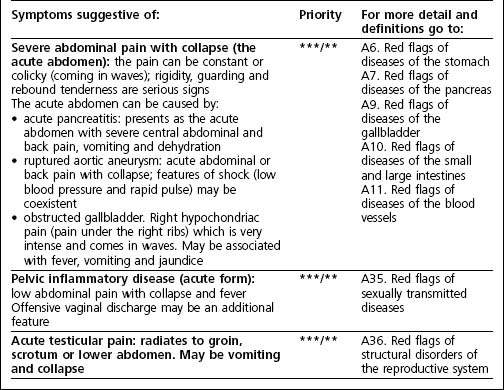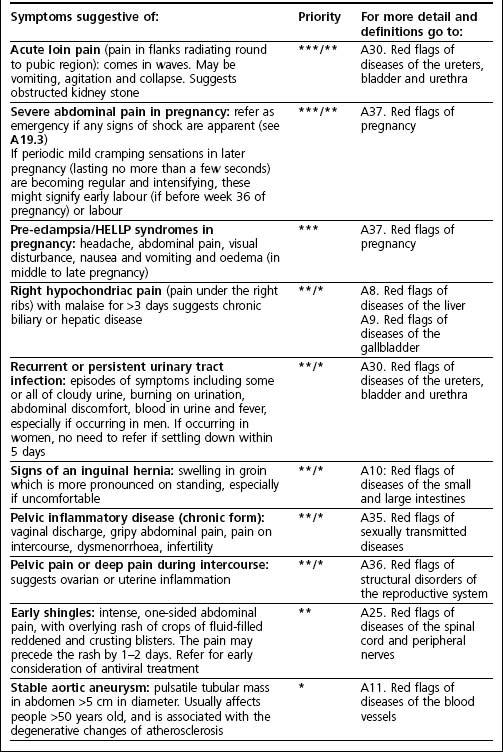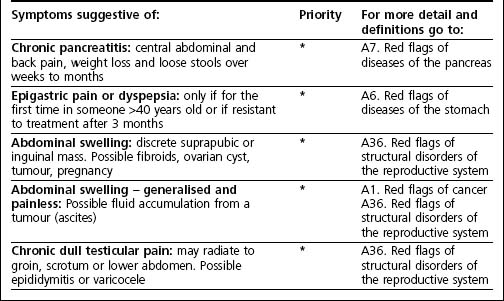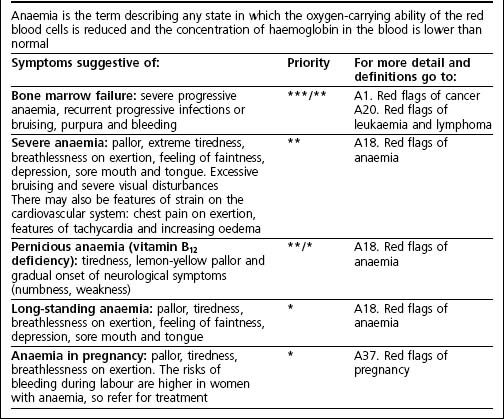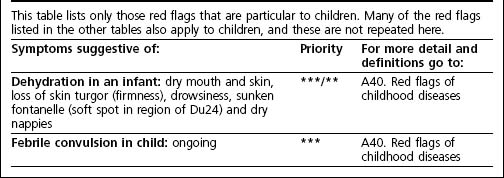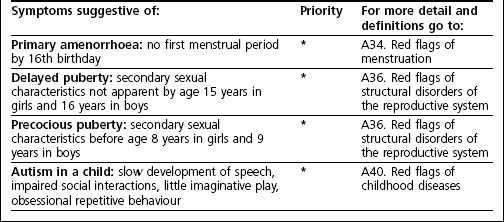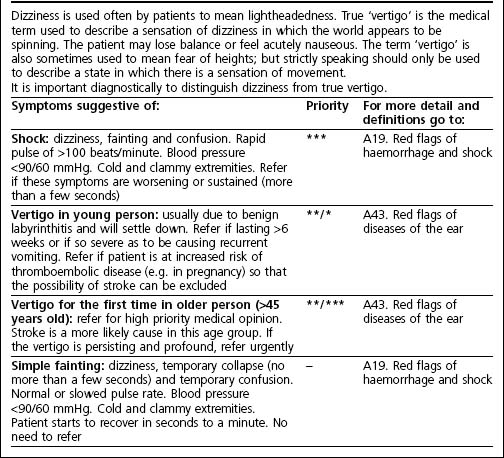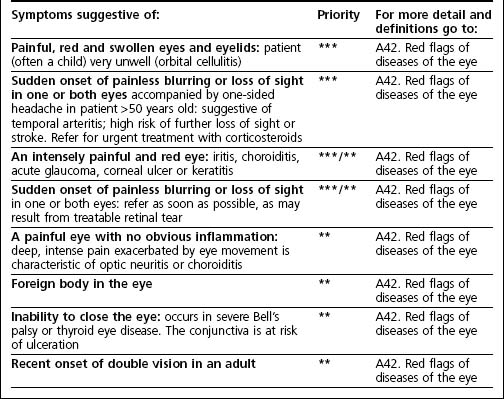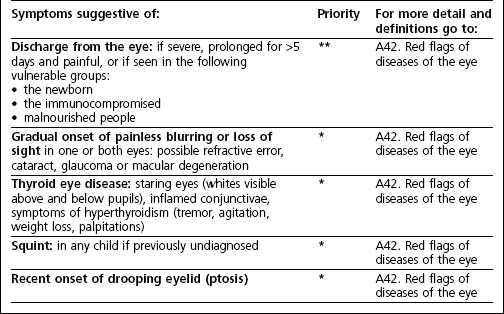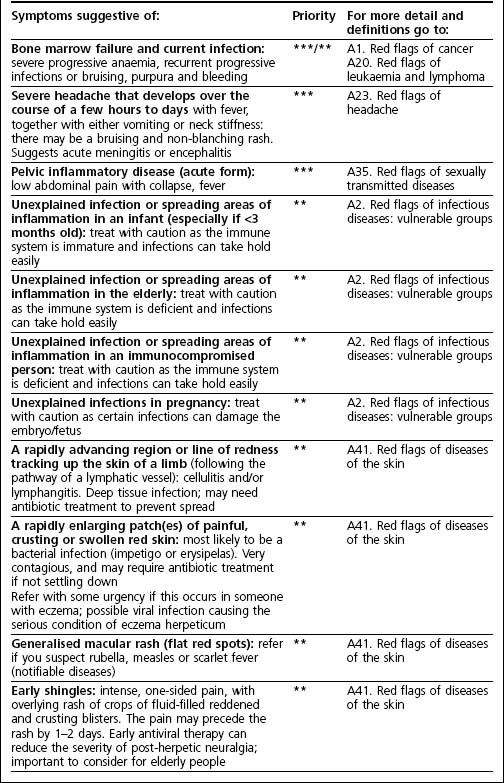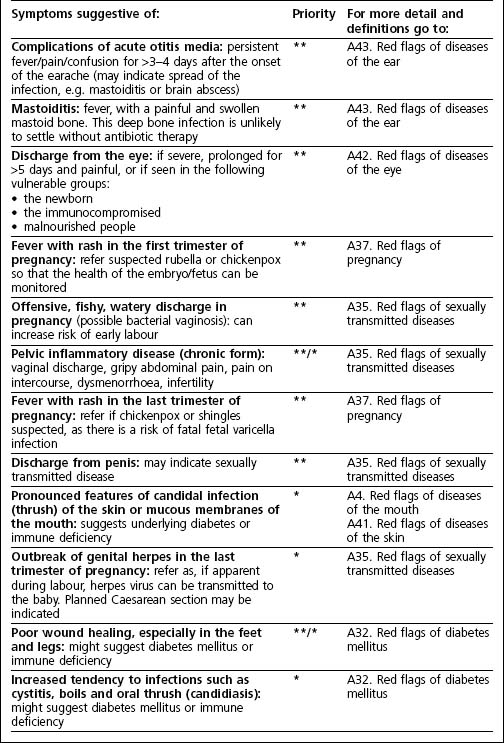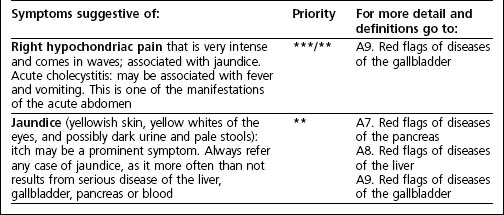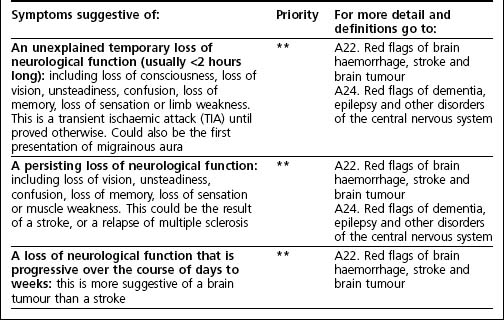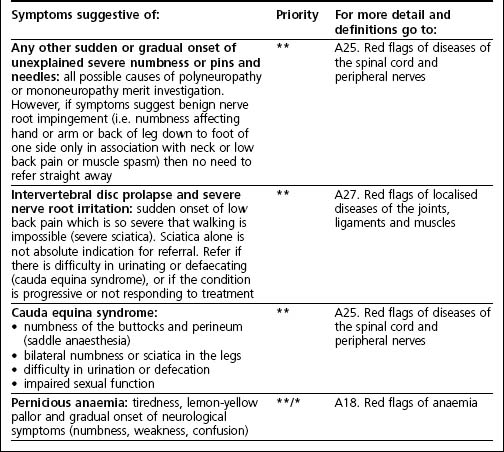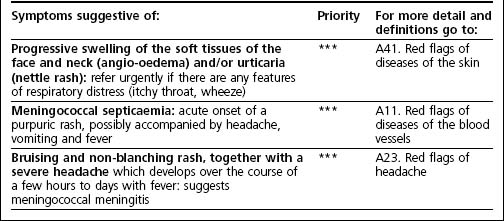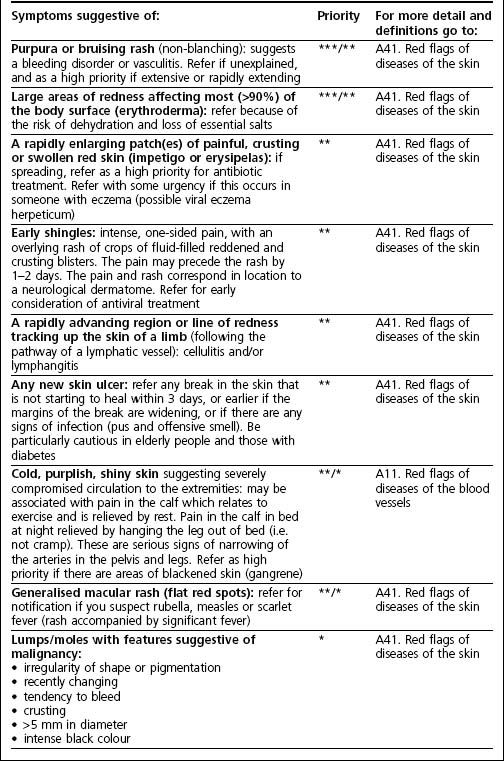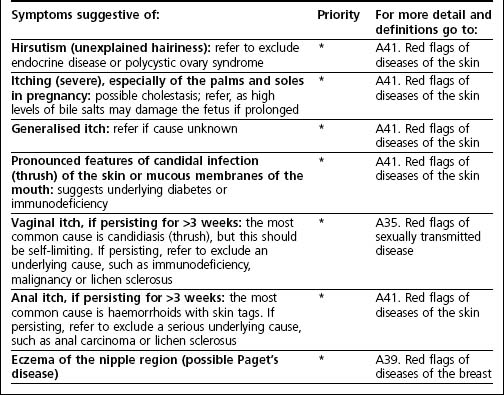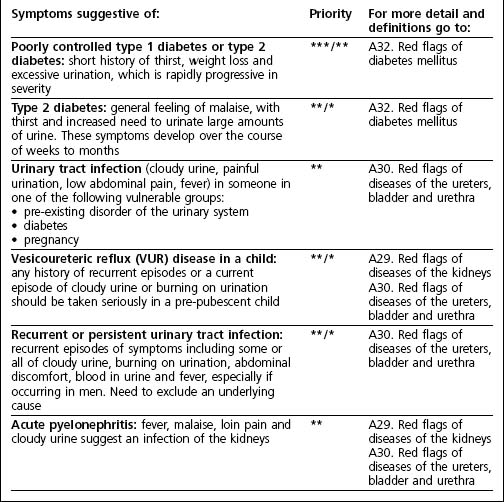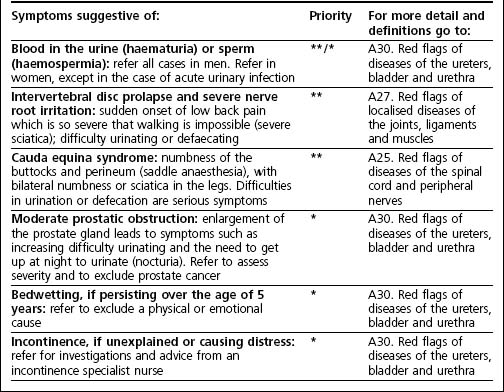Chapter 3 B tables
Red flags ordered by symptom keyword
Introduction
The B tables present red flags ordered by symptom keyword. In each table the red flags are also prioritised according to urgency so that those meriting the most rapid response are found at the top of the list.
These lists are designed for quick access and summarise information in a very brief way. The reader is in all cases given a reference to lead them to consult the explanations found in the A tables in Chapter 2 for more detailed explanations and definitions of medical terms.
The order of the B tables can be found in the contents pages of this text.
TABLE B3 Red flags of anxiety or agitation
| Symptoms suggestive of: | Priority | For more detail and definitions go to: |
|---|---|---|
| Hypoglycaemia (due to effects of insulin or antidiabetic medication in excess of bodily requirements): agitation, sweating, dilated pupils, confusion and coma | *** | A32. Red flags of diabetes mellitus |
| Hallucinations, delusions or other evidence of thought disorder together with evidence of deteriorating self-care and personality change. All features of a psychosis such as schizophrenia. Suicide risk is high Refer urgently if behaviour is posing a risk to the patient or others |
***/** | A44. Red flags of mental health disorders |
| Mania: increasing agitation, grandiosity, pressure of speech and sleeplessness with delusional thinking. All features of bipolar disorder, a form of psychosis, which carries a high risk of behaviour that can be both socially and physically damaging to the patient. Suicide risk is high Refer urgently if behaviour is posing a risk to the patient or others |
***/** | A44. Red flags of mental health disorders |
| Post-natal psychosis: delusional or paranoid ideas and hallucinations are key features. This condition is associated with a high risk of suicide or harm to the baby Refer urgently if behaviour is posing a risk to the patient or others |
***/** | A38. Red flags of the puerperium |
| Organic mental health disorder (i.e. due to underlying gross physical abnormality): confusion, agitation, deterioration in intellectual skills, loss of ability to care for self. (Possible organic brain disorder such as drug intoxication, brain damage or dementia) | ***/** | A44. Red flags of mental health disorders |
| Hyperthyroidism: irritability, anxiety, sleeplessness, increased appetite, loose stools, weight loss, scanty periods and heat intolerance. Signs: sweaty skin, tremor of the hands, staring eyes and rapid pulse | **/* | A31. Red flags of diseases of the thyroid gland |
| Severe depression/obsessive–compulsive disorder or anxiety: if not responding to treatment and seriously affecting quality of life | * | A44. Red flags of mental health disorders |
| Severe disturbance of body image: resulting in features of progressive anorexia nervosa or bulimia nervosa (e.g. progressive weight loss, secondary amenorrhoea, repeated compulsion to bring about vomiting) | * | A44. Red flags of mental health disorders |
TABLE B4 Red flags of bleeding or blood loss
| Symptoms suggestive of: | Priority | For more detail and definitions go to: |
|---|---|---|
| Severe blood loss leading to shock: if the following symptoms and signs have been present for more than a few minutes (i.e. not just simple faint) or are worsening: dizziness, fainting and confusion. Rapid pulse of >100 beats/minute. Blood pressure <90/50 mmHg. Cold and clammy extremities | *** | A19. Red flags of haemorrhage and shock |
| Bone marrow failure: symptoms of progressive anaemia, recurrent progressive infections, progressive bruising, purpura and bleeding | ***/** | A20. Red flags of leukaemia and lymphoma |
| Vomiting of fresh blood or altered blood (haematemesis): if blood is altered, it looks like dark gravel or coffee grounds in the vomit | ***/** | A6. Red flags of diseases of the stomach A8. Red flags of diseases of the liver |
| Altered blood in stools (melaena): stools look like black tar. Suggests large amount of bleeding from stomach | ***/** | A6. Red flags of diseases of the stomach |
| Any episode of vaginal bleeding in pregnancy: refer as an emergency if any signs of shock are apparent (low blood pressure, fainting, rapid pulse), as internal bleeding may not become immediately apparent. Otherwise refer as a high priority for investigation of cause | ***/** | A37. Red flags of pregnancy |
| Post-partum haemorrhage: if bleeding after childbirth is any more than a blood-stained discharge A profuse bleed of >500 mL or the symptoms of shock (low blood pressure, fainting, rapid pulse rate) constitutes an emergency |
***/** | A38. Red flags of the puerperium |
| Continuing blood loss: any situation in which significant bleeding is continuing for more than a few minutes without any signs of abating (e.g. nosebleed), except within the context of menstruation | ***/** | A19. Red flags of haemorrhage and shock |
| Unexplained bleeding: either from the surface of the skin or emerging from an internal organ, such as the bowel, bladder or uterus | ** | A1. Red flags of cancer |
| Infectious bloody diarrhoea or food poisoning: any episode of diarrhoea and vomiting in which food is suspected as the origin, or in which blood appears in the stools. These are notifiable diseases | ** | A10. Red flags of diseases of the small and large intestines |
| Blood mixed in with stools: fresh blood mixed in with the stools suggests colonic or rectal origin Blood that drips after passage of stools is anal in origin and is usually benign (no need to refer) |
** | A10. Red flags of diseases of the small and large intestines |
| Coughing up of blood (haemoptysis): (if on only a single occasion, only amounts more than a teaspoon in volume are significant) | ** | A17. Red flags of lower respiratory disease |
| Tuberculosis infection: chronic productive cough, weight loss, night sweats, blood in sputum for >2 weeks | ** | A17. Red flags of lower respiratory disease |
| Blood in the urine or sperm: refer all cases in men. Refer in women except in the case of acute urinary infection, in which case it is usually benign | **/* | A29. Red flags of diseases of the kidneys A30. Red flags of diseases of the ureters, bladder and urethra |
TABLE B5 Red flags of disorders of the breast
| Symptoms suggestive of: | Priority | For more detail and definitions go to: |
|---|---|---|
| Mastitis in pregnancy or puerperium: if not responding to treatment in 2 days or if features of an abscess (inflamed mass with severe malaise) present | **/* | A38. Red flags of the puerperium A39. Red flags of diseases of the breast |
| Inflamed breast tissue but not breastfeeding: it is rare to develop inflammation if not breastfeeding; may suggest underlying tumour | **/* | A39. Red flags of diseases of the breast |
| Insufficient breast milk: if the mother is considering stopping breastfeeding because of insufficient milk, refer to midwife for breastfeeding advice, as once a baby becomes reliant on formula milk it is often an irreversible decision | **/* | A38. Red flags of the puerperium |
| Lump in the breast: always refer for investigation. One in 10 breast lumps is cancerous | * | A39. Red flags of diseases of the breast |
| Eczema of nipple region: may be due to Bowen’s disease (form of breast cancer) | * | A39. Red flags of diseases of the breast |
| Lactation but not breastfeeding: might suggest pituitary disorder | * | A39. Red flags of diseases of the breast |
| Hypopituitarism: inappropriate lactation, loss of libido, infertility, menstrual disturbances, tiredness, low blood pressure | * | A33. Red flags of other endocrine diseases |
TABLE B6 Red flags of breathlessness or difficulty in breathing (see also B12: red flags of cough)
| Symptoms suggestive of: | Priority | For more detail and definitions go to: |
|---|---|---|
| Severe asthma: at least two of the following – rapidly worsening breathlessness, >30 respirations/minute (or more if a child1), heart rate >110 beats/minute, reluctance to talk because of breathlessness, need to sit upright and still to assist breathing. Cyanosis is a very serious sign | *** | A17. Red flags of lower respiratory disease |
| Infection of the alveoli (pneumonia): cough, fever, malaise, >30 respirations/minute (or more if a child1), heart rate >110 beats/minute, reluctance to talk because of breathlessness, need to sit upright and still to assist breathing. Cyanosis is a very serious sign | ***/** | A17. Red flags of lower respiratory disease |
| Progression of respiratory infection to the lower respiratory tract: breathlessness with malaise suggests the involvement of the bronchi or lower air passages. Usually accompanied by cough and fever, but may be the only symptom of an infection in the elderly or immunocompromised | ***/** | A16. Red flags of upper respiratory disease |
| Pulmonary embolism: sudden onset of pleurisy (chest pain exacerbated by breathing in), with breathlessness, cyanosis, collapse and blood in sputum | *** | A17. Red flags of lower respiratory disease |
| Sudden lung collapse (pneumothorax): onset of severe breathlessness, may be some pleurisy (chest pain exacerbated by breathing in) and collapse if very severe | *** | A17. Red flags of lower respiratory disease |
| Stridor (harsh noisy breathing heard on both the inbreath and outbreath): suggests obstruction to upper airway. Patient will want to sit upright and be still. Don’t ask to examine the tongue | ***/** | A16. Red flags of upper respiratory disease |
| Any new onset of difficulty breathing in a young child (<8 years old): possible asthma (suggested by the presence of cough), chest infection, foreign body in airway, allergic reaction. All need assessing, but some may require urgent treatment | ***/**/* | A16. Red flags of upper respiratory disease |
| Unstable angina or heart attack: sustained intense chest pain associated with fear or dread. Palpitations and breathlessness may be present. The patient may vomit or develop a cold sweat. Beware: in the elderly can present as sudden onset of breathlessness, palpitations or confusion, but without pain | *** | A13. Red flags of angina and heart attack |
| Acute heart failure: sudden onset of disabling breathlessness and watery cough | *** | A14. Red flags of heart failure and arrhythmias |
| Any sudden or gradual onset of muscle weakness that might be affecting muscles of respiration: needs to be referred urgently, as condition may progress to respiratory failure | *** | A25. Red flags of diseases of the spinal cord and peripheral nerves |
| Severe chronic heart failure: marked swelling of ankles and lower legs, disabling breathlessness, cough and exhaustion. There may also be palpitations and chest pain on exertion | ** | A14. Red flags of heart failure and arrhythmias |
| Mild chronic heart failure: slight swelling of ankles, slight breathlessness on exertion and when lying flat, cough, but no palpitations or chest pain | * | A14. Red flags of heart failure and arrhythmias |
| Stable angina: central chest pain related to exertion, eating or the cold which improves with rest. Pain is heavy and gripping (rather than sharp or stabbing), and can radiate down neck and arms Beware: in the elderly can present as episodes of breathlessness/chest tightness, but without pain |
**/* | A13. Red flags of angina and heart attack |
| Complicated pericarditis: sharp central chest pain that is worse on leaning forward and lying down. Fever. Associated palpitations and breathlessness are more serious features | ** | A15. Red flags of pericarditis |
| Pleurisy: localised chest pain which is associated with inspiration and expiration. Refer if associated with fever and breathlessness, as this is an indication of underlying pneumonia | ** | A17. Red flags of lower respiratory disease |
| Long-standing anaemia: pallor, tiredness, breathlessness on exertion, feeling of faintness, depression, sore mouth and tongue | **/* | A18. Red flags of anaemia |
| Unexplained persistent blockage of nostril on one side: in an adult this suggests possible nasopharyngeal carcinoma; refer for investigations if persisting for >3 weeks In a child this suggests obstruction by a foreign body; refer as a high priority |
*/** | A16. Red flags of upper respiratory disease A40. Red flags of childhood diseases |
The normal range for respiratory rate in children varies according to age.
The following rates indicate moderate to severe breathlessness:
1Categorisation of respiratory rate in children:
| newborn (0–3 months) | >60 breaths/minute |
| infant (3 months to 2 years) | >50 breaths/minute |
| young child (2–8 years) | >40 breaths/minute |
| older child to adult | >30 breaths/minute |
TABLE B7 Red flags of bruising and purpura1
| Symptoms suggestive of: | Priority | For more detail and definitions go to: |
|---|---|---|
| Bone marrow failure: severe progressive anaemia, recurrent progressive infections or bruising, purpura and bleeding | ***/** | A1. Red flags of cancer A20. Red flags of leukaemia and lymphoma |
| Severe headache with fever and with a bruising and non-blanching rash: suggests meningococcal meningitis | *** | A23. Red flags of headache |
| Bruising and non-blanching rash with severe malaise: suggests meningococcal septicaemia | *** | A11. Red flags of diseases of the blood vessels |
| Purpura or bruising rash (non-blanching): suggests a bleeding disorder or vasculitis | ***/** | A41. Red flags of diseases of the skin |
| Oedema, bruising and confusion in someone with known liver disease: suggests liver disease has progressed to a serious stage, and the patient is at risk of coma | ** | A8. Red flags of diseases of the liver |
| Severe anaemia: extreme tiredness and breathlessness on exertion, excessive bruising and severe visual disturbances. There may also be features of strain on the cardiovascular system: chest pain on exertion, tachycardia and increasing oedema | ** | A18. Red flags of anaemia |
1Purpura is pinpoint bruising that appears as a rash of small, red, non-blanching macules. It may result from low platelets or from inflammation of the blood vessels (vasculitis).
TABLE B8 Red flags of chest pain
| Symptoms suggestive of: | Priority | For more detail and definitions go to: |
|---|---|---|
| Unstable angina or heart attack: sustained intense chest pain associated with fear or dread. Palpitations and breathlessness may be present. The patient may vomit or develop a cold sweat Beware: in the elderly can present as sudden onset of breathlessness, palpitations or confusion, but without pain |
*** | A13. Red flags of angina and heart attack |
| Pulmonary embolism: sudden onset of pleurisy (chest pain related to breathing in) with breathlessness, cyanosis, collapse and blood in sputum | *** | A17. Red flags of lower respiratory disease |
| Sudden lung collapse (pneumothorax): breathlessness; may be some pleurisy and collapse if very severe | *** | A17. Red flags of lower respiratory disease |
| Complicated pericarditis: sharp central chest pain that is worse on leaning forward and lying down. Fever. Associated palpitations and breathlessness are more serious features | ***/** | A15. Red flags of pericarditis |
| Dissecting aortic aneurysm: sudden onset, tearing chest pain with radiation to back. Features of shock may be present (faintness, low blood pressure, rapid pulse) | *** | A13. Red flags of angina and heart attack |
| Stable angina: central chest pain related to exertion, eating or the cold and which improves with rest. Pain is heavy and gripping (rather than sharp or stabbing), and can radiate down neck and arms Beware: in the elderly can present as episodes of breathlessness/chest tightness, but without pain |
**/* | A13. Red flags of angina and heart attack |
| Uncomplicated pericarditis: sharp central chest pain which is worse on leaning forward and lying down. Fever should be slight and pulse rate no more than 100 beats/minute | ** | A15. Red flags of pericarditis |
| Pleurisy: localised chest pain that is associated with inspiration and expiration. Refer if associated with breathlessness, as this is an indication of associated pneumonia or pulmonary embolism | ** | A17. Red flags of lower respiratory disease |
| New onset of chronic cough or deep persistent chest pain in a smoker: this could be the first sign of bronchial carcinoma | **/* | A17. Red flags of lower respiratory disease |
| Early shingles: intense, one-sided pain, with overlying rash of crops of fluid-filled reddened and crusting blisters. The pain may precede the rash by 1–2 days. Refer for early consideration of antiviral treatment | ** | A25. Red flags of diseases of the spinal cord and peripheral nerves |
TABLE B10 Red flags of collapse and loss of consciousness (see also B11: red flags of confusion and clouding of consciousness)
| Symptoms suggestive of: | Priority | More detail |
|---|---|---|
| Cardiac arrest: collapse with no palpable pulse | *** | A14. Red flags of heart failure and arrhythmias |
| Loss of consciousness (continuing loss of neurological function): diverse causes include stroke, metabolic disease, brain infection, intoxication | *** | A22. Red flags of brain haemorrhage, stroke and brain tumour |
| Rapid increase in intracranial pressure (intracranial haemorrhage): headache followed by a rapid deterioration of consciousness leading to coma. Irregular breathing patterns and pinpoint pupils are a very serious sign May be spontaneous or may result from a head injury |
*** | A21. Red flags of raised intracranial pressure A22. Red flags of brain haemorrhage, stroke and brain tumour |
| First ever epileptic seizure: generalised tonic–clonic seizure: convulsions, loss of consciousness, bitten tongue, emptying of bladder and/or bowels. This is an emergency if the fit does not settle down within 2 minutes. Refer as high priority if fit has settled down | *** | A24. Red flags of dementia, epilepsy and other disorders of the central nervous system |
| A severe headache that develops over the course of a few hours to days with fever, together with either vomiting or neck stiffness. The patient may become drowsy or unconscious. Suggests acute meningitis or encephalitis | *** | A23 Red flags of headache |
| Febrile convulsion in child: ongoing | *** | A3. Red flags of infectious diseases: fever, dehydration and confusion |
| Confusion/coma with dehydration (hyperglycaemia) | *** | A32. Red flags of diabetes mellitus |
| Hypoglycaemia (due to effects of insulin or antidiabetic medication in excess of bodily requirements): agitation, sweating, dilated pupils, confusion and coma | *** | A32. Red flags of diabetes mellitus |
| Pulmonary embolism: sudden onset of pleurisy (chest pain on breathing in) with breathlessness, cyanosis, collapse | *** | A17. Red flags of lower respiratory disease |
| Sudden lung collapse (pneumothorax): onset of severe breathlessness, may be some pleurisy (chest pain on breathing in) and collapse if very severe | *** | A17. Red flags of lower respiratory disease |
| General symptoms of shock: dizziness, fainting and confusion. Rapid pulse of >100 beats/minute. Blood pressure <90/60 mmHg. Cold and clammy extremities. Refer if these symptoms are worsening or sustained (more than a few seconds) | *** | A19. Red flags of haemorrhage and shock |
| Addison’s disease: increased pigmentation of skin, weight loss, muscle wasting, tiredness, loss of libido, low blood pressure, diarrhoea and vomiting, confusion, collapse with dehydration | ***/** | A33. Red flags of other endocrine diseases |
| Febrile convulsion in child: recovered | ** | A40. Red flags of childhood diseases |
| Unexplained falls or faints in elderly person: may be the result of an arrhythmia (cardiac syncope) | **/* | A14 Red flags of heart failure and arrhythmias |
| A temporary loss of neurological function (usually <2 hours long): recovery from loss of consciousness, loss of vision, unsteadiness, confusion, loss of memory, loss of sensation or limb weakness | ** | A22. Red flags of brain haemorrhage, stroke and brain tumour |
| Simple fainting: dizziness, temporary collapse (no more than a few seconds) and temporary confusion. Normal or slowed pulse rate. Blood pressure <90/60 mmHg. Cold and clammy extremities. Patient starts to recover in seconds to a minute. No need to refer | – | A19. Red flags of haemorrhage and shock |
TABLE B11 Red flags of confusion and clouding of consciousness (see also B10: red flags of collapse and loss of consciousness)
| Symptoms suggestive of: | Priority | For more detail and definitions go to: |
|---|---|---|
| General symptoms of shock: dizziness, fainting and confusion. Rapid pulse of >100 beats/minute. Blood pressure <90/60 mmHg. Cold and clammy extremities. Refer if these symptoms are worsening or sustained (more than a few seconds) | *** | A19. Red flags of haemorrhage and shock |
| Hypoglycaemia (due to effects of insulin or antidiabetic medication in excess of bodily requirements): agitation, sweating, dilated pupils, confusion and coma | *** | A32. Red flags of diabetes mellitus |
| Confusion/coma with dehydration (hyperglycaemia) | *** | A32. Red flags of diabetes mellitus |
| Unusual drowsiness in infants (especially if <3 months old): may signify underlying serious illness | ***/** | A2. Red flags of infectious diseases: vulnerable groups |
| Organic mental health disorder (a mental health condition due to an underlying gross physical cause): acute confusion, agitation, visual hallucinations, deterioration in intellectual skills, loss of ability to care for self. (These suggest organic brain disorder such as metabolic disease, drug intoxication, brain damage or dementia) | ***/** | A44. Red flags of mental health disorders |
| A persisting loss of neurological function: including loss of vision, unsteadiness, confusion, loss of memory, loss of sensation or muscle weakness (possible stroke or multiple sclerosis) | *** | A22. Red flags of brain haemorrhage, stroke and brain tumour A24. Red flags of dementia, epilepsy and other disorders of the central nervous system |
| Hallucinations, delusions or other evidence of thought disorder together with evidence of deteriorating self-care and personality change: all are features of a psychosis such as schizophrenia. Suicide risk is high | ***/** | A44. Red flags of mental health disorders |
| Mania: increasing agitation, grandiosity, pressure of speech and sleeplessness with delusional thinking: all are features of bipolar disorder, a form of psychosis that carries a high risk of behaviour that can be both socially and physically damaging to the patient. Suicide risk is high | ***/** | A44. Red flags of mental health disorders |
| Post-natal psychosis: delusional or paranoid ideas and hallucinations are key features. This condition is associated with a high risk of suicide or harm to the baby | ***/** | A38. Red flags of the puerperium |
| Acute confusion in an elderly person: can result from an underlying medical condition, such as stroke, heart attack, infection or pain | ***/** | A2. Red flags of infectious diseases: vulnerable groups |
| Confusion in older children and adults with fever | ** | A3. Red flags of infectious diseases: fever, dehydration and confusion |
| Slow increase in intracranial pressure: progressive headaches and vomiting over the timescale of a few weeks to months. The headaches are worse in the morning and the vomiting may be effortless. Blurring of vision and confusion may be additional symptoms | ** | A21. Red flags of raised intracranial pressure |
| Loss of neurological function which is progressive over the course of days to weeks: may include confusion. This is more suggestive of a brain tumour than a stroke | ** | A22. Red flags of brain haemorrhage, stroke and brain tumour |
| Pernicious anaemia: tiredness, lemon-yellow pallor and gradual onset of neurological symptoms (numbness, weakness, confusion) | **/* | A18. Red flags of anaemia |
| A temporary loss of neurological function (usually <2 hours long): recovery from loss of consciousness, loss of vision, unsteadiness, confusion, loss of memory, loss of sensation or limb weakness (possible transient ischaemic attack (TIA)) | **/* | A22. Red flags of brain haemorrhage, stroke and brain tumour A24. Red flags of dementia, epilepsy and other disorders of the central nervous system |
| Progressive decline in mental and social functioning: increasing difficulty in intellectual function, memory, concentration and use of language | * | A22. Red flags of brain haemorrhage, stroke and brain tumour A24. Red flags of dementia, epilepsy and other disorders of the central nervous system |
| First ever epileptic seizure (complex partial): generalised absence or complex partial seizures: defined periods of vagueness or loss of awareness, or mood or personality changes. Refer any child who has suffered a suspected blank episode (absence) or seizure | * | A24. Red flags of dementia, epilepsy and other disorders of the central nervous system |
| Simple fainting: dizziness, temporary collapse (no more than a few seconds) and temporary confusion. Normal or slowed pulse rate. Blood pressure <90/60 mmHg. Cold and clammy extremities. Patient starts to recover in seconds to a minute. No need to refer | – | A19. Red flags of haemorrhage and shock |
TABLE B12 Red flags of cough (see also B6: red flags of breathlessness and difficulty breathing)
| Symptoms suggestive of: | Priority | For more detail and definitions go to: |
|---|---|---|
| Acute heart failure: sudden onset of disabling breathlessness and watery cough | *** | A14. Red flags of heart failure and arrhythmias |
| Infection of the alveoli (pneumonia): cough, fever, malaise, >30 respirations/minute (or more if a child1), heart rate >110 beats/minute, reluctance to talk because of breathlessness, need to sit upright and be still to assist breathing. Cyanosis is a very serious sign | ***/** | A17. Red flags of lower respiratory disease |
| Progression of infection to the lower respiratory tract: breathlessness1 with malaise suggests the involvement of the bronchi or lower air passages. Usually accompanied by cough and fever, but may be the only symptom of an infection in the elderly or immunocompromised | ***/** | A16. Red flags of upper respiratory disease |
| Any new onset of difficulty breathing in a young child (<8 years old): possible asthma (suggested by coughing as well as difficulty breathing), chest infection, foreign body in airway, allergic reaction. All need assessing, but some may require urgent treatment | ***/**/* | A16. Red flags of upper respiratory disease |
| Progressive upper respiratory infection in susceptible people (e.g. the frail elderly, the immunocompromised and people with pre-existing disease of the bronchi and bronchioles): cough and fever, or new production of yellow–green phlegm, each persisting for >3 days | ** | A16. Red flags of upper respiratory disease A17. Red flags of lower respiratory disease |
| Tuberculosis infection: chronic productive cough, weight loss, night sweats, blood in sputum for >2 weeks | ** | A17. Red flags of lower respiratory disease |
| New onset of chronic cough or deep persistent chest pain in a smoker | **/* | A17. Red flags of lower respiratory disease |
| Severe chronic heart failure: marked swelling of ankles and lower legs, disabling breathlessness, cough and exhaustion. There may also be palpitations and chest pain on exertion | ** | A14. Red flags of heart failure and arrhythmias |
| Coughing up of blood (haemoptysis): (if on only a single occasion, only amounts more than a teaspoon in volume are significant) | ** | A17. Red flags of lower respiratory disease |
| Mild chronic heart failure: slight swelling of ankles, slight breathlessness on exertion and when lying flat, cough, but no palpitations or chest pain. Dry cough may be the only symptom in sedentary elderly people | * | A14. Red flags of heart failure and arrhythmias |
Categorisation of respiratory rate in children:
The normal range for respiratory rate in children varies according to age.
The following rates indicate moderate to severe breathlessness:
1Categorisation of respiratory rate in adults:
– Normal respiratory rate in an adult: 10–20 breaths/minute (one breath is one inhalation and exhalation).
| newborn (0–3 months) | >60 breaths/minute |
| infant (3 months to 2 years) | >50 breaths/minute |
| young child (2–8 years) | >40 breaths/minute |
| older child to adult | >30 breaths/minute |
TABLE B13 Red flags of dehydration
| Symptoms suggestive of: | Priority | For more detail and definitions go to: |
|---|---|---|
| Dehydration in an infant: signs include dry mouth and skin, loss of skin turgor (firmness), drowsiness, sunken fontanelle (soft spot in the region of acupoint Du24) and dry nappies | ***/** | A3. Red flags of infectious diseases: fever, dehydration and confusion |
| Type 1 diabetes or poorly controlled type 2 diabetes: short history of thirst, weight loss and excessive urination, which is rapidly progressive in severity. Can progress to confusion/coma, with dehydration (due to hyperglycaemia) | ***/** | A32. Red flags of diabetes mellitus |
| Addison’s disease: increased pigmentation of skin, weight loss, muscle wasting, tiredness, loss of libido, low blood pressure, diarrhoea and vomiting, confusion, collapse with dehydration | ***/** | A33. Red flags of other endocrine diseases |
| Dehydration in older children and adults if severe or lasting >48 hours: signs include dry mouth and skin, loss of skin turgor, low blood pressure, dizziness on standing and poor urine output | ** | A3. Red flags of infectious diseases: fever, dehydration and confusion |
TABLE B14 Red flags of depression and exhaustion
| Symptoms suggestive of: | Priority | For more detail and definitions go to: |
|---|---|---|
| Suicidal thoughts with features that suggest serious risk: old age, male sex, social isolation, concrete plans in place | ** | A44. Red flags of mental health disorders |
| Severe anaemia: extreme tiredness and breathlessness on exertion, excessive bruising and severe visual disturbances. There may also be features of strain on the cardiovascular system: chest pain on exertion, features of tachycardia and increasing oedema | ** | A18. Red flags of anaemia |
| Long-standing anaemia: pallor, tiredness, breathlessness on exertion, feeling of faintness, depression, sore mouth and tongue | **/* | A18. Red flags of anaemia |
| Type 2 diabetes: general feeling of unwellness, with thirst and increased need to urinate large amounts of urine, which develop over the course of weeks to months | **/* | A32. Red flags of diabetes mellitus |
| Pernicious anaemia: tiredness, lemon-yellow pallor and gradual onset of neurological symptoms (numbness, weakness, confusion) | **/* | A18. Red flags of anaemia |
| Hypopituitarism: loss of libido, infertility, menstrual disturbances, tiredness, low blood pressure, inappropriate lactation | **/* | A33. Red flags of other endocrine diseases |
| Postnatal depression lasting >3 weeks which is not responding to your treatment: refer straight away if the woman is experiencing suicidal ideas, or if you believe the health of the baby to be at risk | ** | A38. Red flags of the puerperium |
| Hypothyroidism (symptoms and signs tend to be progressive over the course of a few months). Symptoms: tiredness, depression, weight gain, heavy periods, constipation and cold intolerance. Signs: dry puffy skin, dry and thin hair, slow pulse | * | A31. Red flags of diseases of the thyroid gland |
| Severe disturbance of body image: if not responding to your treatment, and resulting in features of progressive anorexia nervosa or bulimia nervosa (progressive weight loss, secondary amenorrhoea, or repeated compulsion to bring about vomiting) | * | A44. Red flags of mental health disorders |
TABLE B16 Red flags of diseases of the ear
| Symptoms suggestive of: | Priority | For more detail and definitions go to: |
|---|---|---|
| Sudden onset of absolute deafness (one-sided or bilateral): needs same-day, specialist assessment | ** | A43. Red flags of diseases of the ear |
| Complications of acute otitis media: persistent fever/pain/confusion for >3–4 days after the onset of the earache (may indicate spread of the infection, e.g. mastoiditis or brain abscess) | ** | A43. Red flags of diseases of the ear |
| Mastoiditis: fever, with a painful and swollen mastoid bone. Serious infection; needs same-day assessment and treatment | ** | A43. Red flags of diseases of the ear |
| Earache in an adult for >3 weeks: may suggest nasopharyngeal pathology; refer to exclude cancer | * | A43. Red flags of diseases of the ear |
| Persistent discharge (lasting >2 weeks) from the ear (chronic otitis media/otitis externa): risk of permanent damage to ear from chronic inflammation; refer for assessment and treatment | * | A43. Red flags of diseases of the ear |
| Gradual onset of relative deafness in adult for >7 days (exclude earwax as a cause if possible): deafness from respiratory infection should have cleared by this time; refer to exclude progressive cause, including acoustic neuroma | * | A43. Red flags of diseases of the ear |
| Tinnitus, if progressive (constant or variable tinnitus is common and usually benign): refer to exclude progressive cause, including acoustic neuroma | * | A43. Red flags of diseases of the ear |
| New onset of difficulty hearing in a child lasting for >3 weeks (especially if interfering with school and social interactions): prolonged deafness can affect the development of a child; refer for assessment and treatment if not responding to yours | * | A43. Red flags of diseases of the ear |
| Symptoms suggestive of: | Priority | For more detail and definitions go to: |
|---|---|---|
| Meningococcal septicaemia: acute onset of a purpuric rash, possibly accompanied by headache, vomiting and fever | *** | A11. Red flags of diseases of the blood vessels |
| A severe headache that develops over the course of a few hours to days, with fever, and together with either vomiting or neck stiffness: suggests acute meningitis or encephalitis | *** | A23. Red flags of headache |
| Febrile convulsion in child: ongoing | *** | A3. Red flags of infectious diseases: fever, dehydration and confusion |
| Fever of any level in an immunocompromised person: treat with caution, as could be the only sign of serious infection. Refer if you have any uncertainty about the case | ** | A2. Red flags of infectious diseases: vulnerable groups |
| High fever in a child (<8 years old) if high (>38.5°C) and not responding to treatment within 2 hours | ** | A3. Red flags of infectious diseases: fever, dehydration and confusion |
| Fever in pregnancy if high (>38.5°C) and no response to treatment in 24 hours: refer early, as risk to fetus | ** | A37. Red flags of pregnancy |
| Fever in the puerperium: any case of fever developing in the first 2 weeks of the puerperium (temperature >38°C for >24 hours). Refer early, as possible uterine infection | ** | A38. Red flags of the puerperium |
| Fever of any level in an infant (especially if <3 months old): treat with caution, as could be the only sign of serious underlying disease. Refer if you have any uncertainty about the case | ** | A2. Red flags of infectious diseases: vulnerable groups |
| Fever of any level in an elderly person: treat with caution, as could be the only sign of serious underlying disease. Refer if you have any uncertainty about the case | ** | A2. Red flags of infectious diseases: vulnerable groups |
| Fever of any level in anyone with a recent history of travel to a tropical country (within the past month): treat with caution, as could be a sign of tropical disease. Refer if you have any uncertainty about the case | ** | A2. Red flags of infectious diseases: vulnerable groups |
| High fever in an older child or adult (>38.5°C) which does not respond to treatment within 48 hours | ** | A3. Red flags of infectious diseases: fever, dehydration and confusion |
| Any fever that persists or recurs over >2 weeks: possible chronic infection, inflammatory process or cancer | ** | A1. Red flags of cancer A3. Red flags of infectious diseases: fever, dehydration and confusion |
| Febrile convulsion in child: recovered | ** | A3. Red flags of infectious diseases: fever, dehydration and confusion |
TABLE B19 Red flags of headache
| Symptoms suggestive of: | Priority | For more detail and definitions go to: |
|---|---|---|
| A sudden very severe headache that comes on out of the blue: the patient needs to lie down, and may vomit. There may be neck stiffness (reluctance to move the head) and dislike of bright light. This suggests subarachnoid (intracranial) haemorrhage | *** | A23. Red flags of headache |
| Severe headache that develops over the course of a few hours to days with fever, together with either vomiting or neck stiffness: there may be a bruising and non-blanching rash. Suggests acute meningitis or encephalitis | *** | A23. Red flags of headache |
| Malignant hypertension: diastolic hypertension >120 mmHg, with symptoms including recently worsening headaches, blurred vision, chest pain | ***/** | A12. Red flags of hypertension |
| Pre-eclampsia/HELLP syndromes: headache, abdominal pain, visual disturbance, nausea and vomiting and oedema (in middle to late pregnancy) | *** | A37. Red flags of pregnancy |
| Severe, one-sided headache over the temple occurring for the first time in an elderly person or in someone with polymyalgia rheumatica: possible temporal arteritis. Blurring or loss of sight are very serious signs | ***/** | A23. Red flags of headache |
| Long history of worsening (progressive) headaches: especially with generalised symptoms such as fever, loss of appetite, exhaustion or neurological symptoms. Suggests malignancy or brain abscess | **/* | A23. Red flags of headache |
| Slow increase in intracranial pressure: progressive headaches and vomiting over the timescale of a few weeks to months. The headaches are worse in the morning and the vomiting may be effortless. Blurring of vision and confusion may be additional symptoms | ** | A21. Red flags of raised intracranial pressure A22. Red flags of brain haemorrhage, stroke and brain tumour |
| Growth of a pituitary tumour: progressive headaches, visual disturbance and double vision | **/* | A33. Red flags of other endocrine diseases |
| Acromegaly (growth hormone excess): thickening of facial features and soft tissues, enlarged hands and feet, headaches, high blood pressure | **/* | A33. Red flags of other endocrine diseases |
| Trigeminal neuralgia (and other forms of one-sided facial pain): lancinating pain, on one side of the face, which radiates out from a focal point in response to defined triggers. May be associated with twitching (tic douloureux) | * | A25. Red flags of diseases of the spinal cord and peripheral nerves |
TABLE B20 Red flags of hypertension
| Symptoms suggestive of: | Priority | For more detail and definitions go to: |
|---|---|---|
| Malignant hypertension: diastolic hypertension >120 mmHg, with symptoms including recently worsening headaches, blurred vision, chest pain | ***/** | A12. Red flags of hypertension |
| Pre-eclampsia/HELLP syndromes: headache, abdominal pain, visual disturbance, nausea and vomiting, and oedema (in middle to late pregnancy). Often follows a rise in blood pressure | *** | A34. Red flags of pregnancy |
| Seriously high hypertension: systolic pressure ≥220 mmHg, diastolic pressure ≥120 mmHg, but no symptoms | ** | A12. Red flags of hypertension |
| Moderate to severe pregnancy-induced hypertension: diastolic pressure >100 mmHg or systolic pressure >140 mmHg. Arrange same-day assessment with midwife | ** | A37. Red flags of pregnancy |
| Severe hypertension: systolic pressure ≥180 mmHg, diastolic pressure ≥110 mmHg. Refer as high priority if major risk factors1 are present. Otherwise, refer for treatment if there is no improvement in 2 weeks | * | A12. Red flags of hypertension |
| Moderate hypertension: systolic pressure ≥160 mmHg and <180 mmHg, diastolic pressure ≥100 mmHg and <110 mmHg. Refer for assessment if risk factors1 are present, otherwise only refer if there is no improvement within 4 weeks | * | A12. Red flags of hypertension |
| Mild hypertension: systolic pressure ≥140 mmHg and <160 mmHg, diastolic pressure ≥90 mmHg and <100 mmHg. Refer for assessment if risk factors1 are present, otherwise refer only if there is no improvement within 3 months | * | A12. Red flags of hypertension |
| Mild pregnancy-induced hypertension: diastolic pressure 90–99 mmHg, systolic pressure <140 mmHg | * | A37. Red flags of pregnancy |
| Potential pregnancy-induced hypertension: systolic pressure is 30 mmHg or diastolic pressure is 15 mmHg above any measurement taken previously in pregnancy | * | A37. Red flags of pregnancy |
| Hypertension of any level with established kidney disease | * | A12. Red flags of hypertension |
| Hypertension of any level with diabetes | * | A12. Red flags of hypertension |
| Cushing’s syndrome: weight gain, weakness and wasting of limb muscles, stretch marks and bruises. Mood changes, hypertension, red cheeks, acne | * | A28. Red flags of other endocrine diseases |
| Acromegaly (growth hormone excess): thickening of facial features and soft tissues, enlarged hands and feet, headaches, high blood pressure | * | A28. Red flags of other endocrine diseases |
1In this case, major risk factors are features that are known to be associated with increased risk of a cardiovascular event in the presence of hypertension. These include diabetes, past history of heart disease, chronic leg ischaemia and kidney disease.
TABLE B23 Red flags of lumps, masses and glands
| Symptoms suggestive of: | Priority | For more detail and definitions go to: |
|---|---|---|
| A single, grossly enlarged tonsil: patient unwell, feverish and has foul-smelling breath. This suggests quinsy, which is a surgical emergency as breathing may be compromised | ***/** | A16. Red flags of upper respiratory disease |
| Tender or inflamed gums or salivary glands which do not respond within days to your treatment | ** | A4. Red flags of diseases of the mouth |
| Any unexplained lump >1 cm in diameter: especially if hard, irregular, fixed and painless | * | A1. Red flags of cancer |
| A single markedly enlarged lymph node (>2 cm in diameter) with no obvious cause and persisting for more than 2 weeks | * | A1. Red flags of cancer A20. Red flags of leukaemia and lymphoma |
| Multiple enlarged painless lymph nodes (>1 cm in diameter) with no other obvious cause (e.g. known glandular fever infection) and persisting for more than 2 weeks | * | A1. Red flags of cancer A20. Red flags of leukaemia and lymphoma |
| A single, grossly enlarged tonsil: patient generally well. If patient appears well, lymphoma is a possible diagnosis. Systemic symptoms may include fever, night sweats and weight loss | * | A16. Red flags of upper respiratory disease |
| Painless enlargement of a salivary gland over weeks to months: possible salivary tumour | * | A4. Red flags of diseases of the mouth |
| Painful or painless enlargement of a salivary gland immediately after eating: suggests salivary gland stone; refer if does not settle down in a week, or sooner if painful | * | A4. Red flags of diseases of the mouth |
| Goitre: refer only if symptoms of hyperthyroidism or hypothyroidism are present, or if the goitre is tender, irregular or noticeably enlarging. Small, smooth, rubbery goitres are common and benign | * | A31. Red flags of diseases of the thyroid gland |
| Any lump in the breast: refer, as 1 in 10 of all breast lumps show malignant change | * | A39. Red flags of diseases of the breast |
| Any lump in the testis: refer as, although usually benign, early diagnosis of testicular cancer has a very good prognosis | * | A36. Red flags of structural disorders of the reproductive system |
| Breast tissue development in adult men (gynaecomastia): although common, benign and transitory in teenage boys, breast lumps in men should be referred to exclude cancer | * | A39. Red flags of diseases of the breast |
| Abdominal swelling: discrete mass in suprapubic or iliac fossa regions: possible fibroids, ovarian cyst, tumour, pregnancy | * | A36. Red flags of structural disorders of the reproductive system |
| Signs of an inguinal hernia: swelling in groin that is more pronounced on standing, especially if uncomfortable | * | A10. Red flags of disorders of the small and large intestines |
| Painless lump felt in anus: refer to exclude serious conditions of anal warts and anal carcinoma | * | A10. Red flags of disorders of the small and large intestines |
| Painful lump felt in anus: refer to exclude strangulated haemorrhoid, which will require a surgical opinion | **/* | A10. Red flags of disorders of the small and large intestines |
| Any lumps/moles with features suggestive of malignancy: recent change in size, irregularity of shape or pigmentation, a tendency to bleed, crusting, >5 mm in diameter, intense black colour | * | A41. Red flags of diseases of the skin |
TABLE B24 Red flags of disorders of menstruation
| Symptoms suggestive of: | Priority | For more detail and definitions go to: |
|---|---|---|
| Postpartum haemorrhage: refer if bleeding is any more than a blood-stained discharge after childbirth. A profuse bleed of >500 mL or the symptoms of shock (low blood pressure, fainting, rapid pulse rate) constitutes an emergency | ***/** | A38. Red flags of the puerperium |
| Menorrhagia (heavy periods) with features of severe anaemia (tiredness, breathlessness, palpitations on exertion) | ** | A34. Red flags of menstruation |
| Vaginal discharge: if irregular, blood-stained or unusual smell | **/* | A35. Red flags of sexually transmitted diseases |
| Hyperthyroidism. Symptoms: irritability, anxiety, sleeplessness, increased appetite, loose stools, weight loss, scanty periods and heat intolerance. Signs: sweaty skin, tremor of the hands, staring eyes and rapid pulse | **/* | A31. Red flags of diseases of the thyroid gland |
| Post-menopausal bleeding: any unexplained bleeding after the menopause | * | A34. Red flags of menstruation |
| Pelvic inflammatory disease (chronic form): vaginal discharge, gripy abdominal pain, pain on intercourse, dysmenorrhoea (painful periods), infertility | * | A35. Red flags of sexually transmitted diseases |
| Primary amenorrhoea: after age 16 years No menstrual period by the time of the 16th birthday |
* | A34. Red flags of menstruation |
| Secondary amenorrhoea: for >12 months Cessation of menstrual periods |
* | A34. Red flags of menstruation |
| Metrorrhagia: bleeding between periods that has no regular pattern. This includes post-coital bleeding (bleeding after intercourse) | * | A34. Red flags of menstruation |
| Severe disturbance of body image: with features of progressive anorexia nervosa or bulimia nervosa (e.g. progressive weight loss, secondary amenorrhoea or repeated compulsion to bring about vomiting) and not responding to your treatment in 3 weeks | * | A44. Red flags of mental health disorders |
| Hypopituitarism: loss of libido, infertility, menstrual disturbances, tiredness, low blood pressure, inappropriate lactation | * | A33. Red flags of other endocrine diseases |
TABLE B25 Red flags of disorders of the mouth
| Symptoms suggestive of: | Priority | For more detail and definitions go to: |
|---|---|---|
| Painful ulceration of mouth: if persistent or if preventing proper hydration | **/* | A4. Red flags of diseases of the mouth |
| Enlarged or inflamed gums or salivary glands which do not respond within days to your treatment | **/* | A4. Red flags of diseases of the mouth |
| Long-standing anaemia: pallor, tiredness, breathlessness on exertion, feeling of faintness, depression, sore mouth and tongue | **/* | A18. Red flags of anaemia |
| Persistent oral thrush (candidiasis) (appearing as a thick white coating on tongue or palate): suggests underlying diabetes mellitus or immune deficiency | * | A4. Red flags of diseases of the mouth |
| Persistent, painless, white plaque (leukoplakia) on the tongue (appearing as a coat that appears to sit on the surface of the sides of the tongue): this is a pre-malignant change | * | A4. Red flags of diseases of the mouth |
TABLE B26 Red flags of muscle tremor and spasms
| Symptoms suggestive of: | Priority | For more detail and definitions go to: |
|---|---|---|
| Tremor with features of hyperthyroidism (symptoms and signs tend to be progressive over the course of a few months). Symptoms: irritability, anxiety, sleeplessness, increased appetite, loose stools, weight loss, scanty periods and heat intolerance. Signs: sweaty skin, staring eyes and rapid pulse | **/* | A31. Red flags of diseases of the thyroid gland |
| First ever epileptic seizure – focal simple seizures: episodes of coarse twitching of one part of the body | ** | A22. Red flags of brain haemorrhage, stroke and brain tumour |
| Progressive coarse tremor appearing in middle to late life: possible Parkinson’s or Huntingdon’s disease (coarse tremor); distinguish from benign essential tremor (a fine tremor that worsens with anxiety), which does not require referral | * | A24. Red flags of dementia, epilepsy and other disorders of the central nervous system |
| Symptoms suggestive of: | Priority | For more detail and definitions go to: |
|---|---|---|
| Progressive swelling of the soft tissues of the face and neck (angio-oedema) and/or urticaria (nettle rash): refer urgently if there are any features of respiratory distress (itchy throat/wheeze) | *** | A41. Red flags of diseases of the skin |
| Severe chronic heart failure: marked swelling of the ankles and lower legs, disabling breathlessness, cough and exhaustion | ** | A14. Red flags of heart failure and arrhythmias |
| Unexplained oedema (excess tissue fluid, manifesting primarily as ankle swelling extending to >2 cm above the malleoli): possible acute or chronic kidney disease | ** | A29. Red flags of diseases of the kidneys |
| Severe anaemia: extreme tiredness and breathlessness on exertion, excessive bruising, and severe visual disturbances. There may also be features of strain on the cardiovascular system: chest pain on exertion, features of tachycardia and increasing oedema | ** | A18. Red flags of anaemia |
| Oedema, bruising and confusion in someone with known liver disease: suggests liver disease has progressed to a serious stage | ** | A8. Red flags of diseases of the liver |
| Oedema in pregnancy: swelling of ankles is common, but refer if extending >2 cm above the malleoli or if facial oedema is apparent | ** | A37. Red flags of pregnancy |
| Mild chronic heart failure: slight swelling of the ankles, slight breathlessness on exertion and when lying flat, cough, but no palpitations or chest pain | * | A14. Red flags of heart failure and arrhythmias |
TABLE B29 Red flags of pain in the bones, joints or muscles
| Symptoms suggestive of: | Priority | For more detail and definitions go to: |
|---|---|---|
| Limb infarction (suddenly extremely pale, painful, mottled and cold limb): results from a clot in major artery. The life of the limb is threatened | *** | A11. Red flags of diseases of the blood vessels |
| Polymyalgia rheumatica with new onset of one-sided headache: prolonged pain and stiffness of the muscles of the hips and shoulders, associated with malaise and depression. Refer urgently if there is a sudden onset of a severe, one-sided temporal headache or visual disturbances (possible temporal arteritis) | ***/** | A28. Red flags of generalised diseases of the joints, ligaments and muscles |
| Severely compromised circulation to the extremities: pain in the calf which is related to exercise and relieved by rest. Pain in the calf in bed at night relieved by hanging the leg out of bed (i.e. not cramp). Cold, purplish, shiny skin. Areas of blackened skin (gangrene) | **/* | A11. Red flags of diseases of the blood vessels |
| Deep vein thrombosis: hot, swollen, tender calf; can be accompanied by fever and malaise. Increased risk after air travel and surgery, in pregnancy and cancer, and if on the oral contraceptive pill | ** | A11. Red flags of diseases of the blood vessels |
| Bone pain: characteristically fixed and deep. It may have either an aching or a boring quality. Tenderness on palpation and on percussion. Refer to exclude underlying inflammation or fracture of the bone, both of which result from serious conditions | **/* | A26. Red flags of diseases of the bones |
| Inflammatory arthritis: symmetrical pain, stiffness and swelling of the joints, or symmetrical stiffness and pain in the sacroiliac joint. May be associated with fever or a sense of malaise | **/* | A28. Red flags of generalised diseases of the joints, ligaments and muscles |
| Septic or crystal arthritis: a single, hot, swollen and very tender joint. The patient is unwell. Risk of inflammatory damage to the joint | ** | A27. Red flags of localised diseases of the joints, ligaments and muscles |
| Traumatic injury to a muscle or joint (which may require surgical treatment or immobilisation): sudden onset of pain or swelling in a joint (possible haemarthrosis); sudden severe pain and swelling around a joint, with reluctance to move (sprain or strain or possible fracture); locking of the knee joint (meniscal cartilage tear); sudden onset of tender swelling in a muscle (possible haematoma) | ** | A27. Red flags of localised diseases of the joints, ligaments and muscles |
| Intervertebral disc prolapse and severe nerve root irritation: sudden onset of low back pain which is so severe that walking is impossible (severe sciatica). Difficulty urinating or defecating | ** | A27. Red flags of localised diseases of the joints, ligaments and muscles |
| Pubic symphysis pain in pregnancy: refer if the patient is significantly hindered in activities of daily living | ** | A37. Red flags of pregnancy |
| Persistent loin pain (i.e. pain in the flanks either side of the spine between the levels of T11 and L3): pain might be radiating from the kidneys | ** | A29. Red flags of diseases of the kidneys |
| Degenerative arthritis that may benefit from joint replacement: severe disability from long-standing pain and stiffness in the hips, knees or shoulders | * | A28. Red flags of generalised diseases of the joints, ligaments and muscles |
TABLE B30 Red flags of palpitations or abnormal pulse rate
| Symptoms suggestive of: | Priority | For more detail and definitions go to: |
|---|---|---|
| Unstable angina or heart attack: sustained, intense chest pain associated with fear or dread. Palpitations and breathlessness may be present. The patient may vomit or develop a cold sweat Beware: in the elderly can present as sudden onset of breathlessness, palpitations or confusion, but without pain |
*** | A13. Red flags of angina and heart attack |
| General symptoms of shock: dizziness, fainting and confusion. Rapid pulse of >100 beats/minute. Blood pressure <90/60 mmHg. Cold and clammy extremities. Refer if these symptoms are worsening or sustained (more than a few seconds) | *** | A19. Red flags of haemorrhage and shock |
| A very rapid pulse (140–250 beats/minute): most likely to be supraventricular tachycardia or atrial fibrillation. Refer urgently if ongoing, and as a high priority if has settled down but was the first ever episode | ***/** | A14. Red flags of heart failure and arrhythmias |
| A very slow pulse (40–50 beats/minute) (complete heart block): refer if either of recent onset or if associated with features of shock, such as dizziness, light-headedness or fainting | ***/** | A14. Red flags of heart failure and arrhythmias |
| Severe chronic heart failure: marked swelling of the ankles and lower legs, palpitations, disabling breathlessness, exhaustion | ** | A14. Red flags of heart failure and arrhythmias |
| Complicated pericarditis: palpitations, fever and sharp central chest pain that is worse on leaning forward and lying down. There may be breathlessness due to acute cardiac failure. This is a serious sign | ** | A15. Red flags of pericarditis |
| An irregularly irregular pulse (atrial fibrillation): refer, as there is a risk of embolic stroke as small blood clots can develop in chaotically contracting atria of the heart | **/* | A14. Red flags of heart failure and arrhythmias |
| Palpitations in pregnancy: refer if it seems that there is any form of arrhythmia in pregnancy. The increased cardiac output in pregnancy can expose previously undiagnosed congenital heart disease | ** | A37. Red flags of pregnancy |
| Hyperthyroidism (symptoms and signs tend to be progressive over the course of a few months). Symptoms: irritability, palpitations, anxiety, sleeplessness, increased appetite, loose stools, weight loss, scanty periods and heat intolerance. Signs: sweaty skin, tremor of the hands, staring eyes and rapid pulse | **/* | A31. Red flags of diseases of the thyroid gland |
| A pulse that is regular but skips beats at regular intervals (i.e. one out of every 3–5 beats is missing): suggests incomplete heart block. This is an arrhythmia that may precede more serious arrhythmias. Refer for investigation of cause | * | A14. Red flags of heart failure and arrhythmias |
| Hypothyroidism (symptoms and signs tend to be progressive over the course of a few months). Symptoms: tiredness, depression, weight gain, heavy periods, constipation and cold intolerance. Signs: dry puffy skin, dry and thin hair, slow pulse | * | A26. Red flags of diseases of the thyroid gland |
TABLE B31 Red flags of pregnancy and the puerperium
| Symptoms suggestive of: | Priority | For more detail and definitions go to: |
|---|---|---|
| Pre-eclampsia/HELLP syndromes: headache, abdominal pain, visual disturbance, nausea and vomiting, and oedema (in middle to late pregnancy). These symptoms and signs are serious indicators of the dangerous syndromes of eclampsia and haemolysis/liver abnormalities and low platelets, both of which can threaten the life of the mother and the fetus | *** | A37. Red flags of pregnancy |
| Thromboembolism: pain in the calf, swollen or discoloured leg, or breathlessness with chest pain, or blood in sputum in pregnancy or the puerperium. These symptoms and signs are serious at all times, but are listed here as they are more likely to develop in pregnancy and the puerperium, as there is an increased tendency for the blood to form clots at these stages | *** | A37. Red flags of pregnancy |
| Abdominal pain: refer any episode of sustained abdominal pain in pregnancy as an emergency, particularly if any signs of shock are apparent (low blood pressure, fainting, rapid pulse), as internal bleeding may not be immediately apparent. Abdominal pain may be the first sign of pre-eclampsia. Periodic mild cramping sensations in later pregnancy (lasting no more than a few seconds) are likely to be Braxton Hicks contractions, but if becoming regular and intensifying, beware that these might signify premature labour (if before week 36 of pregnancy) or labour | *** | A37. Red flags of pregnancy |
| Bleeding: refer any episode of vaginal bleeding in pregnancy. Refer as an emergency if any signs of shock are apparent (low blood pressure, fainting, rapid pulse), as internal bleeding may not be immediately apparent | ***/** | A37. Red flags of pregnancy |
| Post-natal psychosis: delusional or paranoid ideas and hallucinations are key features. This condition is associated with a high risk of suicide or harm to the baby | ***/** | A38. Red flags of the puerperium |
| Nausea and vomiting with dehydration for >1 day in pregnancy | ** | A37. Red flags of pregnancy |
| Moderate to severe pregnancy-induced hypertension: refer as a high priority if the diastolic pressure is >100 mmHg or if the systolic pressure is >140 mmHg | ** | A37. Red flags of pregnancy |
| Mild pregnancy-induced hypertension: refer for assessment if the diastolic pressure is 90–99 mmHg and the systolic pressure is <140 mmHg | ** | A37. Red flags of pregnancy |
| Fever with rash in the first trimester of pregnancy: refer suspected rubella or chickenpox so that health of the embryo/fetus can be monitored | ** | A37. Red flags of pregnancy |
| Fever with rash in the last trimester of pregnancy: refer if chickenpox or shingles is suspected, as there is a risk of fatal fetal varicella infection | ** | A37. Red flags of pregnancy |
| Offensive, fishy, watery discharge: possible bacterial vaginosis; there is an increased risk of stillbirth and premature labour | ** | A35. Red flags of sexually transmitted diseases |
| Any watery vaginal leakage in middle to late pregnancy: this is amniotic fluid until proved otherwise | ** | A37. Red flags of pregnancy |
| Fever in the puerperium: refer any case of fever developing in the first 2 weeks of the puerperium (temperature >38°C for >24 hours) as there is a risk this could result from uterine infection | ** | A38. Red flags of the puerperium |
| Mastitis when breastfeeding if not responding to treatment in 2 days, or if there are features of an abscess: mastitis is very debilitating, and if not settling may need antibiotic treatment | **/* | A38. Red flags of the puerperium |
| Insufficient breast milk or sore nipples: if the mother is considering stopping breastfeeding because of insufficient milk or soreness, refer to the midwife, health visitor or breastfeeding counsellor for breastfeeding advice; the problem may be in the technique, and not a true reflection of low milk production | **/* | A38. Red flags of the puerperium |
| Post-natal depression lasting for >3 weeks and not responding to your treatment: refer straight away if the woman is experiencing suicidal ideas, or if you believe the health of the baby to be at risk | **/* | A38. Red flags of the puerperium |
| Itching (severe), especially of the palms and soles in pregnancy: may result from cholestasis (build up of bile salts); refer, as there is a theoretical risk to the health of the fetus if levels rise too high | ** | A41. Red flags of diseases of the skin |
| Oedema in pregnancy: refer all but mild ankle swelling; may result from a kidney or heart problem | * | A37. Red flags of pregnancy |
| Pubic symphysis pain in pregnancy: refer if the patient is significantly hindered in activities of daily living, as the prescription of a pelvic brace can be a great help | * | A37. Red flags of pregnancy |
| Anaemia in pregnancy: the risks of bleeding during labour are higher in women with anaemia, so refer for assessment and advice about treatment | * | A37. Red flags of pregnancy |
| Outbreak of genital herpes in the last trimester of pregnancy: may be an indication for a Caesarean section to prevent the baby contracting the herpesvirus (can be fatal) as it passes through the birth canal | * | A35. Red flags of sexually transmitted diseases |
| Potential pregnancy-induced hypertension: refer for assessment if the systolic pressure has risen by 30 mmHg or the diastolic pressure by 15 mmHg above any measurement you have taken previously | * | A37. Red flags of pregnancy |
TABLE B33 Red flags of disorders of speech
| Symptoms suggestive of: | Priority | For more detail and definitions go to: |
|---|---|---|
| Persistent loss of ability to speak clearly: might result from a persistent loss of neurological function (other features include loss of vision, unsteadiness, confusion, loss of memory, loss of sensation, or muscle weakness). Most likely cause is stroke (thrombotic or haemorrhagic). Needs referring urgently for rapid access to hospital treatment | *** | A22. Red flags of brain haemorrhage, stroke and brain tumour A24. Red flags of dementia, epilepsy and other disorders of the central nervous system |
| Brief loss of ability to speak clearly: suggests a temporary loss of neurological function (usually <2 hours), such as loss of consciousness, loss of vision, unsteadiness, confusion, loss of memory, loss of sensation or limb weakness. If migraine not previously diagnosed, most likely cause is transient ischaemic attack (TIA) | ** | A22. Red flags of brain haemorrhage, stroke and brain tumour A24. Red flags of dementia, epilepsy and other disorders of the central nervous system |
| Progressive loss of ability to speak clearly: may result from a loss of neurological function that is progressive over the course of days to weeks. This is more suggestive of a brain tumour than a stroke. Could also result from multiple sclerosis or motor neurone disease | ** | A22. Red flags of brain haemorrhage, stroke and brain tumour |
| Unexplained hoarseness lasting for >3 weeks: may be the first symptom of laryngeal or lung cancer (particularly in smokers >50 years old) | * | A17. Red flags of lower respiratory disease |
TABLE B34 Red flags of disorders of swallowing
| Symptoms suggestive of: | Priority | For more detail and definitions go to: |
|---|---|---|
| Difficulty swallowing (dysphagia) that is worse with solids (in particular if progressive over days to weeks): suggests a physical obstruction and, if progressive, oesophageal cancer is a possible diagnosis (weight loss is strongly suggestive of this) Other possible causes are oesophageal stricture, oesophageal web (can form in severe anaemia) and candidiasis of the oesophagus (a feature of AIDS). Neurological disease (e.g. stroke and motor neurone disease) can also cause dysfunctional swallowing, and in this case even swallowing of fluids may be difficult Refer for diagnosis and treatment Discomfort in swallowing that does not affect the eating of solids or drinking is very likely to be benign, and does not merit referral |
**/* | A5. Red flags of diseases of the oesophagus |
| Difficulty swallowing (dysphagia) associated with enlarged lymph nodes in the neck: lymph node enlargement suggests the possibility of cancer or an inflammatory mass in the neck (e.g. tuberculous abscess) | **/* | A5. Red flags of diseases of the oesophagus |
| Swallowing associated with central chest pain (behind the sternum): may result from oesophageal inflammation, an oesophageal tear or a lodged foreign body (fish bone). Refer if persisting for more than a day, or if getting worse | ** | A5. Red flags of diseases of the oesophagus |
| Symptoms suggestive of: | Priority | For more detail and definitions go to: |
|---|---|---|
| Poorly controlled type 1 diabetes or type 2 diabetes: short history of thirst, weight loss and excessive urination, which is rapidly progressive in severity | ***/** | A32. Red flags of diabetes mellitus |
| Type 2 diabetes: general feeling of unwellness, with thirst and increased need to urinate large amounts of urine. These symptoms develop over the course of weeks to months | **/* | A32. Red flags of diabetes mellitus |
TABLE B37 Red flags of visual disturbance
| Symptoms suggestive of: | Priority | For more detail and definitions go to: |
|---|---|---|
| Blurred vision in malignant hypertension: diastolic pressure >120 mmHg, with symptoms including recently worsening headaches, blurred vision and chest pain | ***/** | A12. Red flags of hypertension |
| Blurred vision in pre-eclampsia/HELLP syndromes: headache, abdominal pain, visual disturbance, nausea and vomiting, and oedema (in middle to late pregnancy) | *** | A37. Red flags of pregnancy |
| Sudden blurring of vision with a one-sided headache in an older person: consider temporal arteritis if there is no history of migraine. Refer urgently for steroid treatment, as the risk of blindness and stroke is high | *** | A42. Red flags of diseases of the eye |
| A temporary, persisting or progressive loss of clarity of sight due to brain dysfunction: may result from loss of neurological function in migraine, transient ischaemic attack or stroke. Other symptoms include loss of consciousness, loss of vision, unsteadiness, confusion, loss of memory, loss of sensation or limb weakness. Refer urgently if the loss of neurological function is persisting and as a high priority if temporary | **/*** | A22. Red flags of brain haemorrhage, stroke and brain tumour A24. Red flags of dementia, epilepsy and other disorders of the central nervous system |
| Painless sudden loss of sight: may result from retinal detachment, vitreous detachment or retinal artery thrombosis. Refer as a high priority to the emergency department, as retinal detachment is treatable if caught early | ** | A42. Red flags of diseases of the eye |
| Visual disturbance from the growth of a pituitary tumour: features include progressive headaches, visual disturbance and double vision | **/* | A33. Red flags of other endocrine diseases |
| Severe anaemia: extreme tiredness and breathlessness on exertion, excessive bruising and severe visual disturbances suggest that the anaemia is very severe. There may also be features of strain on the cardiovascular system: chest pain on exertion, features of tachycardia and increasing oedema | ** | A18. Red flags of anaemia |
| Thyroid eye disease (vision only affected if very advanced). Symptoms: irritability, anxiety, sleeplessness, increased appetite, loose stools, weight loss, scanty periods and heat intolerance. Signs: sweaty skin, tremor of the hands, staring eyes and rapid pulse | **/* | A31. Red flags of diseases of the thyroid gland |
| Optic neuritis: blurred vision with deep aching pain in the eye. Associated with multiple sclerosis. Refer for diagnosis | ** | A42. Red flags of diseases of the eye |
TABLE B38 Red flags of vomiting and/or passage of faeces
| Symptoms suggestive of: | Priority | For more detail and definitions go to: |
|---|---|---|
| Severe headache that develops over the course of a few hours to days with fever, together with either vomiting or neck stiffness: possible acute meningitis or encephalitis | *** | A23. Red flags of headache |
| Meningococcal septicaemia: acute onset of purpuric rash, possibly accompanied by headache, vomiting and fever | *** | A11. Red flags of diseases of the blood vessels |
| Diarrhoea and vomiting associated with features of dehydration | ***/** | A6. Red flags of diseases of the stomach |
| Severe diarrhoea and vomiting if lasting >24 hours in infants or the elderly | ***/** | A6. Red flags of diseases of the stomach |
| Projectile vomiting persisting for >2 days | ***/** | A6. Red flags of diseases of the stomach |
| Vomiting of fresh blood or altered blood (looks like dark gravel or coffee grounds) | ***/** | A6. Red flags of diseases of the stomach A8. Red flags of diseases of the liver |
| Right hypochondriac pain that is very intense and comes in waves: may be associated with fever and vomiting. May be associated with jaundice. This is one of the manifestations of the acute abdomen | ***/** | A9. Red flags of diseases of the gallbladder |
| Addison’s disease: increased pigmentation of skin, weight loss, muscle wasting, tiredness, loss of libido, low blood pressure, diarrhoea and vomiting, confusion, collapse with dehydration | ***/** | A33. Red flags of other endocrine diseases |
| Diarrhoea and/or vomiting in an elderly person: treat with caution, as the elderly are prone to dehydration, and diarrhoea and vomiting may be presenting features of more serious underlying disease | ** | A2. Red flags of infectious diseases: vulnerable groups |
| Diarrhoea and/or vomiting in infants (especially if <3 months old): treat with caution, as infants are prone to dehydration, and diarrhoea and vomiting may be presenting features of more serious underlying disease | ** | A2. Red flags of infectious diseases: vulnerable groups |
| Diarrhoea and/or vomiting in an immunocompromised person: treat with caution; diarrhoea and vomiting may be features of a serious infection in people who are immunocompromised | ** | A2. Red flags of infectious diseases: vulnerable groups |
| Diarrhoea and vomiting if continuing for >5 days in otherwise healthy adults: most mild infections should have settled down in 2–3 days; needs further investigation | ** | A6. Red flags of diseases of the stomach |
| Diarrhoea with mucus or gripy pain if not responding to treatment within a week: possible inflammatory bowel disease or parasitic infection | ** | A10. Red flags of diseases of the small and large intestines |
| Altered bowel habit lasting for >3 weeks in a patient >50 years old | **/* | A10. Red flags of diseases of the small and large intestines |
| Infectious bloody diarrhoea or food poisoning: an episode of diarrhoea and vomiting in which food is suspected as the origin or in which blood appears in the stools: these are notifiable diseases | ** | A10. Red flags of diseases of the small and large intestines |
| Nausea and vomiting with dehydration (dry skin, dry mouth, low blood pressure, low skin turgor) for >1 day in pregnancy: patient may need fluid replacement | ** | A37. Red flags of pregnancy |
| Cauda equina syndrome: numbness of the buttocks and perineum (saddle anaesthesia), with bilateral numbness or sciatica in the legs; difficulty in urination or defecation are serious symptoms | ** | A25 Red flags of diseases of the spinal cord and peripheral nerves |
| Soiling of stool or anal discharge (in underwear or bed) in a previously continent child or adult: may signify constipation in both children and the elderly, and also emotional distress in a child. In adults, anal discharge may be a sign of anorectal carcinoma | * | A10. Red flags of diseases of the small and large intestines |
| Slow increase in intracranial pressure: progressive headaches and vomiting over a timescale of a few weeks to months. The headaches are worse in the morning, and the vomiting may be effortless. Blurring of vision and confusion may be additional symptoms | ** | A21. Red flags of raised intracranial pressure |
| Vertigo (dizziness) in young person: usually due to benign labyrinthitis and will settle down. Refer if lasting for >6 weeks, or if so severe as to be causing recurrent vomiting. Refer if patient is at increased risk of thromboembolic disease (e.g. in pregnancy) so that the possibility of stroke can be excluded | **/* | A43. Red flags of diseases of the ear |
| Vertigo (dizziness) in an older person (>45 years old): refer for medical assessment straightaway. Although still more likely to be a result of inner ear disease, stroke is also a possible cause in this age group | ** | A43. Red flags of diseases of the ear |
| Hyperthyroidism. Symptoms: irritability, anxiety, sleeplessness, increased appetite, loose stools, weight loss, scanty periods and heat intolerance. Signs: sweaty skin, tremor of the hands, staring eyes and rapid pulse | **/* | A31. Red flags of diseases of the thyroid gland |
TABLE B39 Red flags of weakness/paralysis
| Symptoms suggestive of: | Priority | For more detail and definitions go to: |
|---|---|---|
| Any sudden or gradual onset of muscle weakness that might be affecting muscles of respiration: refer urgently | *** | A25. Red flags of diseases of the spinal cord and peripheral nerves |
| Addison’s disease: increased pigmentation of skin, weight loss, muscle wasting, tiredness, loss of libido, low blood pressure, diarrhoea and vomiting, confusion, collapse with dehydration | ***/** | A33. Red flags of other endocrine diseases |
| Weakness that results from a temporary, progressive or persisting loss of neurological function: suggested by accompanying symptoms such as loss of consciousness, loss of vision, unsteadiness, confusion, loss of memory or loss of sensation. Possible stroke, transient ischaemic attack or brain tumour Refer urgently if persisting and high priority if temporary |
**/*** | A22. Red flags of brain haemorrhage, stroke and brain tumour A24. Red flags of dementia, epilepsy and other disorders of the central nervous system |
| Any sudden or gradual onset of muscle weakness that can be objectively assessed (i.e. not just the patient’s perception of weakness): refer to exclude serious muscular or neurological condition (e.g. myasthenia gravis, polymyositis, peripheral neuropathy or mononeuropathy, motor neurone disease) | **/* | A25. Red flags of diseases of the spinal cord and peripheral nerves |
| Cauda equina syndrome: numbness of the buttocks and perineum (saddle anaesthesia), with bilateral numbness, weakness or sciatica in the legs. Difficulty in urination or defecation are serious symptoms | ** | A25. Red flags of diseases of the spinal cord and peripheral nerves |
| Bell’s palsy: sudden onset of facial weakness; almost always unilateral. Refer for same-day treatment with antiviral and steroid medication | ** | A25. Red flags of diseases of the spinal cord and peripheral nerves |
| Cushing’s syndrome: weight gain, weakness and wasting of limb muscles, stretch marks and bruises. Mood changes, hypertension, red cheeks, acne | * | A33. Red flags of other endocrine diseases |
TABLE B40 Red flags of weight loss or weight gain
| Symptoms suggestive of: | Priority | For more detail and definitions go to: |
|---|---|---|
| Progressive unexplained symptoms over weeks to months (e.g. weight loss, recurrent sweats, fevers, poor appetite): may be cancer, HIV or tuberculosis | **/* | A1. Red flags of cancer |
| Malabsorption syndrome (loose, pale stools and malnutrition): weight loss, thin hair, dry skin, cracked lips and peeled tongue. Will present as failure to thrive in children. Causes include coeliac disease and chronic pancreatitis | **/* | A7. Red flags of diseases of the pancreas A10. Red flags of diseases of the small and large intestines |
| Tuberculosis infection: chronic productive cough, weight loss, night sweats, blood in sputum for >2 weeks | ** | A17. Red flags of lower respiratory disease |
| Hyperthyroidism (symptoms and signs tend to be progressive over the course of a few months). Symptoms: irritability, anxiety, sleeplessness, increased appetite, loose stools, weight loss, scanty periods and heat intolerance. Signs: sweaty skin, tremor of the hands, staring eyes and rapid pulse | **/* | A31. Red flags of diseases of the thyroid gland |
| Severe disturbance of body image: if not responding to your treatment, and resulting in features of progressive anorexia nervosa or bulimia nervosa (e.g. progressive weight loss, secondary amenorrhoea, or repeated compulsion to bring about vomiting) | * | A44. Red flags of mental health disorders |
| Hypothyroidism (symptoms and signs tend to be progressive over the course of a few months). Symptoms: tiredness, depression, weight gain, heavy periods, constipation and cold intolerance. Signs: dry puffy skin, dry and thin hair, slow pulse | * | A31. Red flags of diseases of the thyroid gland |
| Cushing’s syndrome: weight gain, weakness and wasting of limb muscles, stretch marks and bruises. Mood changes, hypertension, red cheeks, acne | * | A33. Red flags of other endocrine diseases |
